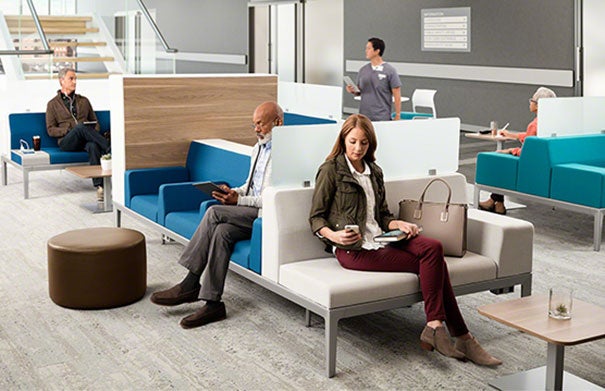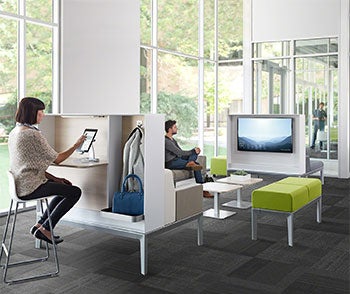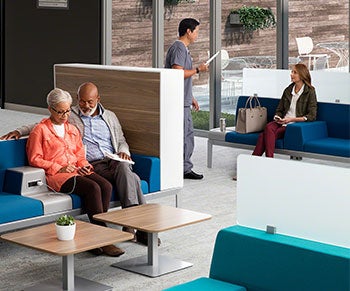Waiting rooms may be a missed opportunity in facility design
 |
| Courtesy of Steelcase Health In a recent study, Steelcase Health observed patient preferences in waiting rooms, such as where patients sit and how they interact with the environment. |
Hospital waiting rooms may be one of the first areas a patient sees, but according to research from Steelcase Health, it sometimes is one of the last areas hospitals pay attention to.
The furniture company partnered with an academic medical research center and observed patients' behavioral patterns while sitting in waiting rooms. Over five days, the researchers observed and captured more than 75 behavior maps of patients and their families. The observations zeroed in on three things:
- Observed seating choice to determine family group sizes and grouping patterns
- Understood family needs to determine potential furniture and process changes
- Examined relationship between environmental variables and the patient experience
While focusing on these three aspects, the researchers found four major missed opportunities. For one, there was not enough seating with direct sight lines to information sources, such as near digital monitors or in optimal proximity to the door separating clinical spaces from which names are called. A lack of room to store personal items — purses, mobile devices, laptops, drinks, etc. — was also noticeable.
 |
| Courtesy of Steelcase Health Diversifying the seating options in wating rooms allows patients to use the space in a way that best suits them. |
 |
The third thing researchers say missed the mark was not enough separation from strangers. On the flip side, having no intentional group space for families to gather together was a fourth missed opportunity.
While most hospitals adopt long rows of seating for maximum density, Steelcase Health found that seating arrangements that fit the patient needs, whether it be privacy or a communal space for family members, is a better use of space.
Researchers say health care organizations should focus on three guiding principles for waiting room design: balance sight lines, rethink density and create both separation and togetherness.
"Supportive transition spaces provide spatial separation and information for patients and their families," says Michelle Ossmann, director of health care environments for Steelcase Health. "We're working with health care organizations to create spaces that accommodate a range of activity preferences, integrate technology and information-sharing, and create an emotionally supportive environment. Transforming waiting into productive time makes the experience more meaningful and helps to prepare patients for the next step in their journey."
In the second phase of the study, designers transformed the waiting room of a specialty clinic with new furnishings to create distinct zones, leaving some of the row seating due to wall configurations. Changes included:
- lounge seating with wider seats and armrests
- double seats for family grouping
- chairs with a slight rocking movement for physical support
- augmented the coffee space with a round café table
- moved seating for optimal sideways views instead of out of the windows or directly at staff areas
- plugs in seating bays
- tables with space dividers for additional privacy
- easily wipeable coverings for improved cleanliness
Researchers say that the changes led to increased comfort levels and greater ability to perform activities. For instance, while 20 percent of occupied chairs were taken up by bags and drinks rather than people in the pre-occupancy study, only 16 percent were used for the same purpose in the post-occupancy study. Also, following the redesign, 24 percent of patients were able to comfortably interact with family members.
The study notes that although waiting rooms have not received much attention in the past, health care's growing focus on the patient experience and HCAHPS' role in Medicare reimbursements means health systems should pay more attention to patient comfort throughout the entire care journey, from entry to exit.
The researchers say that in the patient's mind, waiting rooms can serve as a proxy for what type of care they will actually receive. For the savvy patient, who spends lots of times in medical centers, a comfortable waiting area makes a big deal when you know you will spend lots of time there. Even when thinking about the average consumer who is there for an annual visit and doesn't know what to expect, the waiting room can influence their perception of what type of care they will receive even before they see the doctor.




